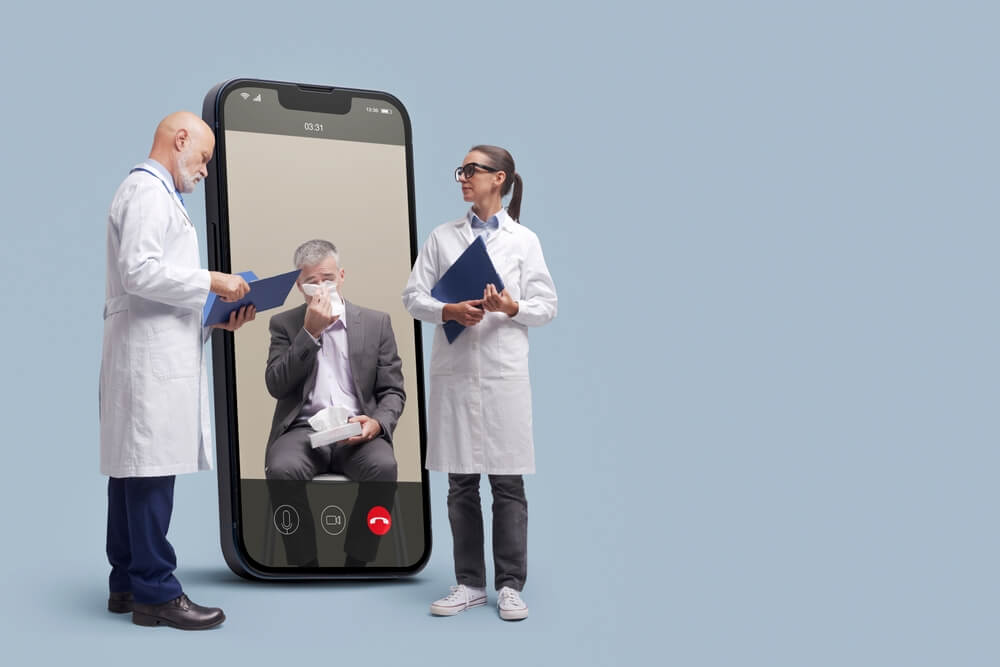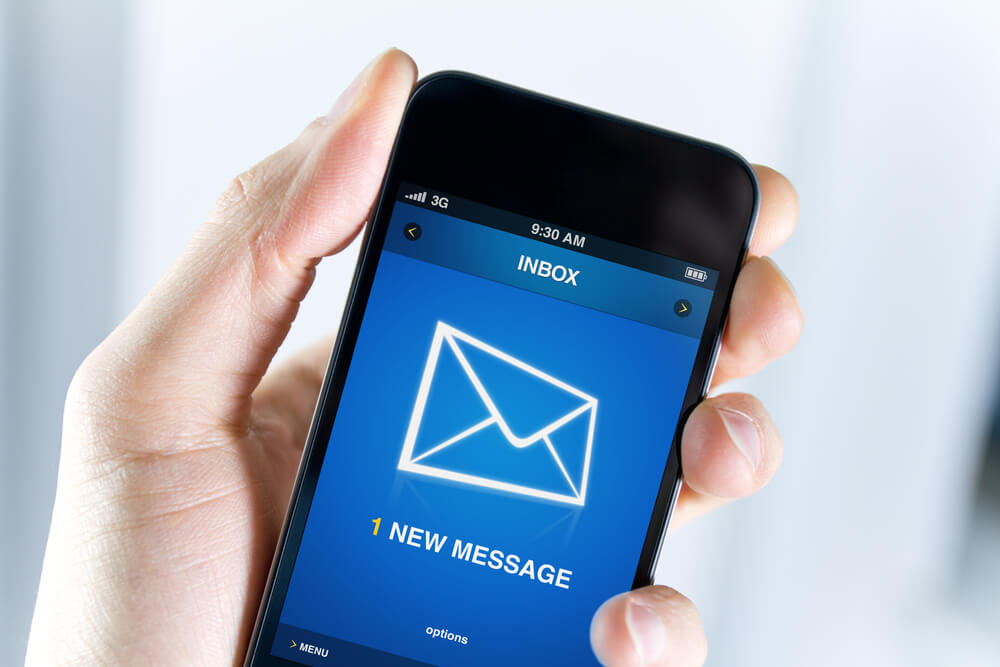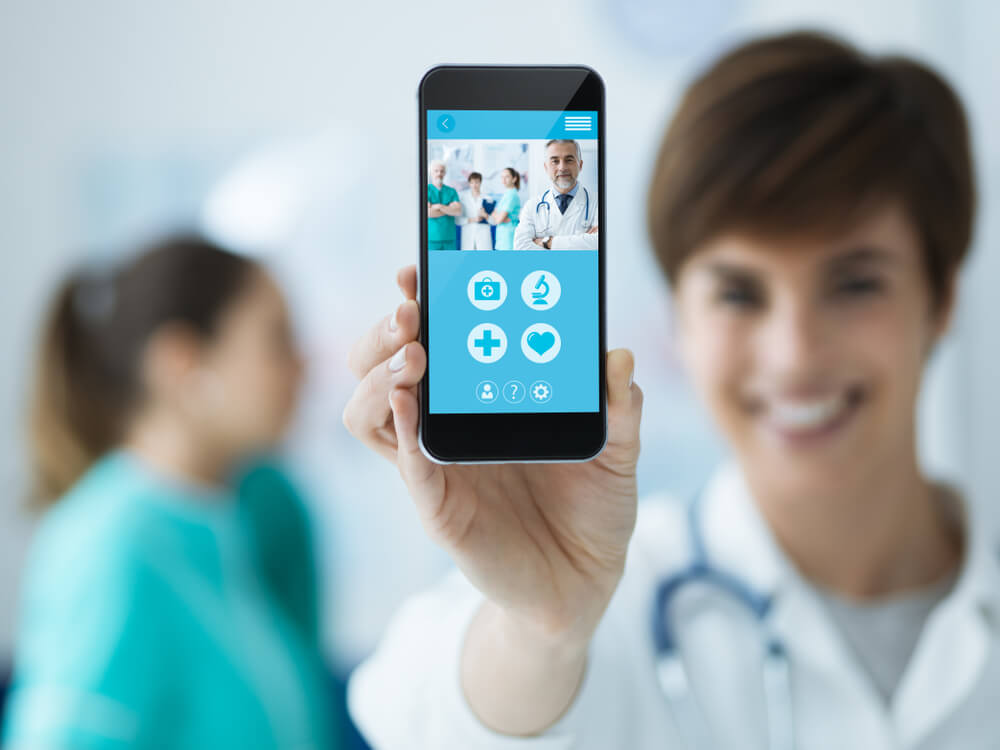
Adapting Healthcare Marketing for Smartphones? 5 Best Practices
In an era of rising smartphone ownership, healthcare providers must optimize their marketing for mobile devices. This article highlights the critical importance of mobile-centric strategies in healthcare marketing, detailing seven best practices for engaging an increasingly mobile user base.
Today, we’ll review and discuss these mobile-centric marketing techniques:
 Local search engine optimization (SEO) enables medical practices, clinics, and hospitals to appear prominently in search results when users seek nearby healthcare services. Local SEO helps smartphone users easily find relevant healthcare information, enhancing the user experience and increasing conversions from online searches to visits.
Healthcare sites can improve local search rankings with these digital marketing best practices:
Local search engine optimization (SEO) enables medical practices, clinics, and hospitals to appear prominently in search results when users seek nearby healthcare services. Local SEO helps smartphone users easily find relevant healthcare information, enhancing the user experience and increasing conversions from online searches to visits.
Healthcare sites can improve local search rankings with these digital marketing best practices:
 SMS marketing and messaging apps provide healthcare providers with immediate, direct communication with patients for reminders, tips, and follow-ups. Compliance with the Health Insurance Portability and Accountability Act of 1996 (HIPAA) and using encrypted apps, alongside obtaining consent, ensure patient data security and privacy in healthcare communications.
Note these tips for utilizing SMS marketing and messaging apps in healthcare communications.
SMS marketing and messaging apps provide healthcare providers with immediate, direct communication with patients for reminders, tips, and follow-ups. Compliance with the Health Insurance Portability and Accountability Act of 1996 (HIPAA) and using encrypted apps, alongside obtaining consent, ensure patient data security and privacy in healthcare communications.
Note these tips for utilizing SMS marketing and messaging apps in healthcare communications.
 The rise of healthcare mobile apps highlights a shift in patient care and engagement. Users can easily access health information, schedule appointments, monitor wellness, and interact with healthcare providers using these apps.
Healthcare mobile apps offer unparalleled marketing opportunities to build patient loyalty, promote services, and personalize interactions. These apps’ direct and ongoing engagement allows marketers to deliver customized content and services.
Use these methods to create personalized healthcare apps that engage patients:
The rise of healthcare mobile apps highlights a shift in patient care and engagement. Users can easily access health information, schedule appointments, monitor wellness, and interact with healthcare providers using these apps.
Healthcare mobile apps offer unparalleled marketing opportunities to build patient loyalty, promote services, and personalize interactions. These apps’ direct and ongoing engagement allows marketers to deliver customized content and services.
Use these methods to create personalized healthcare apps that engage patients:
- Creating a mobile-friendly website design
- Optimizing for local search
- Leveraging social media
- Utilizing SMS and messaging apps
- Developing smartphone-friendly content
- Incorporating mobile apps in healthcare digital marketing
- Tracking and analyzing mobile user engagement
Are you looking for help with marketing your healthcare business? Watch the video below to learn our approach to healthcare marketing and why 150+ healthcare companies have chosen Digital Authority Partners to help them generate more leads and patient appointments.
1. Creating Mobile-Friendly Website Design
A responsive website design means the website adapts to different screen sizes and devices, especially smartphones. Mobile-friendly designs improve user experience and search engine rankings as users access information on the go. Consider these strategies to create a user-friendly mobile experience for patients and clients:- Create simple navigation menus for smaller screens. Clear labels and minimalist design help users find what they need.
- Compress images, cache browser data, and reduce scripts to speed up the website.
- Maintain easy access to important information on the mobile site. Focus on key points and write clearly for mobile users.
- Design a responsive website that works on all screen sizes and orientations.
- Remove unnecessary fields and use auto-fill to simplify mobile forms. For touchscreen use, make buttons and interactive elements large and well-spaced.
- Regularly test mobile site usability and performance across devices and browsers. To improve the mobile experience, gather user feedback and analytics.
2. Optimizing for Local Search
 Local search engine optimization (SEO) enables medical practices, clinics, and hospitals to appear prominently in search results when users seek nearby healthcare services. Local SEO helps smartphone users easily find relevant healthcare information, enhancing the user experience and increasing conversions from online searches to visits.
Healthcare sites can improve local search rankings with these digital marketing best practices:
Local search engine optimization (SEO) enables medical practices, clinics, and hospitals to appear prominently in search results when users seek nearby healthcare services. Local SEO helps smartphone users easily find relevant healthcare information, enhancing the user experience and increasing conversions from online searches to visits.
Healthcare sites can improve local search rankings with these digital marketing best practices:
- Claim the business on Google Business Profile (GBP) and update its address, phone number, hours, and services. Keep the listing updated with new content, photos, and relevant information.
- Use local healthcare and location keywords in website content, meta descriptions, and titles. This helps search engines understand the locality and improves visibility.
- Maintain consistent information on Yelp, Healthgrades, and Yellow Pages.
- Encourage happy patients to leave Google, Yelp, and healthcare review sites reviews. Positive reviews enhance credibility and influence local search rankings.
- Optimize the website for smartphones to make it user-friendly and fast. Google’s algorithms favor mobile-friendly sites for local mobile searches.
- Develop content tailored to the local audience, such as blog posts, articles, or community event coverage related to healthcare in the area.
3. Leveraging Social Media for Mobile Users
Most social media interactions occur on mobile devices, so Facebook, Instagram, X (Twitter), and TikTok can reach a large audience via smartphones. These platforms enable healthcare providers to share content, engage in real-time, and build community among mobile users, facilitating targeted messaging and meaningful connections. These top social media techniques for engaging healthcare content can boost healthcare provider marketing.- Prioritize high-quality images, infographics, videos, and interactive visuals.
- Use concise text, clear headlines, and readable fonts for mobile viewing.
- Create polls, quizzes, and stories to engage mobile users.
- Use healthcare-related hashtags and keywords to increase discoverability.
- Stay consistent with postings to engage and inform readers. Share timely healthcare updates, tips, and relevant information to satisfy mobile users’ content needs.
- Ask questions, start discussions, and respond to comments and messages.
4. Utilizing SMS and Messaging Apps
 SMS marketing and messaging apps provide healthcare providers with immediate, direct communication with patients for reminders, tips, and follow-ups. Compliance with the Health Insurance Portability and Accountability Act of 1996 (HIPAA) and using encrypted apps, alongside obtaining consent, ensure patient data security and privacy in healthcare communications.
Note these tips for utilizing SMS marketing and messaging apps in healthcare communications.
SMS marketing and messaging apps provide healthcare providers with immediate, direct communication with patients for reminders, tips, and follow-ups. Compliance with the Health Insurance Portability and Accountability Act of 1996 (HIPAA) and using encrypted apps, alongside obtaining consent, ensure patient data security and privacy in healthcare communications.
Note these tips for utilizing SMS marketing and messaging apps in healthcare communications.
- Ask permission before sending healthcare information via SMS or messaging apps. Explain the messages they receive and how data will be handled to comply with privacy laws.
- Use encrypted messaging apps that meet healthcare data protection standards. Sending sensitive patient data is safer with these apps.
- Give patients the option to stop receiving messages. Use clear instructions to unsubscribe and respect patients’ privacy.
- Avoid sending sensitive medical data via SMS or messaging apps. Instead of discussing medical conditions or treatments, use these channels for appointment reminders, health tips, and non-sensitive communications.
- Educate healthcare staff involved in communication efforts about compliance regulations such as HIPAA. Help them understand the importance of properly protecting patient data and using SMS or messaging apps.
5. Creating Smartphone-Friendly Content
Digital consumers want easily consumable content more than ever. Smartphone users prefer quick, accessible content like short videos, infographics, and articles. These formats offer visually appealing, easy-to-digest content perfect for smartphone browsing. Customizing content for these formats maximizes smartphone user engagement. Use these healthcare digital marketing methods to format and present mobile content.- Ensure the website and content are responsive to different screen sizes and orientations.
- Label sections with headlines and subheadings for easy scanning. This helps users find relevant information quickly, especially when skimming on smaller screens.
- Present information in short paragraphs with bullet points, numbered lists, and concise sentences. Mobile users like skimmable content for critical issues.
- Compress images and videos for faster loading without sacrificing quality. Use mobile-friendly formats and provide image alt text for accessibility.
- Simplify navigation using clear menus, buttons, and clickable, easily tappable elements on touchscreens. Ensure a logical flow and avoid clutter to enhance the user experience.
- Reduce mobile pop-ups and interstitials that disrupt user experience. If necessary, make sure they are appropriately sized and easily dismissible.
- Limit server response times, use browser caching, and reduce scripts to speed up loading.
6. Incorporating Mobile Apps in Marketing
 The rise of healthcare mobile apps highlights a shift in patient care and engagement. Users can easily access health information, schedule appointments, monitor wellness, and interact with healthcare providers using these apps.
Healthcare mobile apps offer unparalleled marketing opportunities to build patient loyalty, promote services, and personalize interactions. These apps’ direct and ongoing engagement allows marketers to deliver customized content and services.
Use these methods to create personalized healthcare apps that engage patients:
The rise of healthcare mobile apps highlights a shift in patient care and engagement. Users can easily access health information, schedule appointments, monitor wellness, and interact with healthcare providers using these apps.
Healthcare mobile apps offer unparalleled marketing opportunities to build patient loyalty, promote services, and personalize interactions. These apps’ direct and ongoing engagement allows marketers to deliver customized content and services.
Use these methods to create personalized healthcare apps that engage patients:
- Allow patients to schedule, reschedule, and cancel appointments via the app. Notify patients of upcoming appointments to reduce no-shows and improve appointment adherence.
- Include features to track patients’ diet, exercise, medication adherence, and vital signs.
- Enable secure messaging or telehealth in the app for patient-provider communication.
- Provide a library of customizable health education, articles, videos, and interactive content.
- Add feedback and surveys to the app to learn about patient preferences and experiences. Use feedback to improve services, patient care, and the app experience.
- Integrate fitness trackers and smartwatches to sync health data with the app.
7. Tracking and Analyzing Mobile User Engagement
Understanding audience behavior and optimizing healthcare marketing strategies requires tracking and analyzing smartphone user engagement. It reveals which marketing campaigns, content formats, and channels target audiences prefer. By monitoring metrics such as click-through rates (CTR), time spent on content, conversion rates, and user demographics, healthcare marketers can refine their approaches, tailor content, and effectively allocate resources. The following tools and metrics measure mobile user engagement and behavior in healthcare marketing:- Google Analytics. Track mobile traffic, bounce rates, time spent on site, and conversion rates with Google Analytics to understand mobile user behavior on your website or app.
- Heat map tools. Heat maps show user behavior and suggest mobile interface improvements.
- App analytics platforms. Healthcare apps can use Firebase Analytics, Apple App Store Connect, or Google Play Console to track usage, retention, demographics, and in-app behavior. They provide useful data on app features and content engagement.
- Social media analytics. Mobile-specific metrics like engagement rates, clicks, shares, and demographics are available on Facebook, Instagram, and Twitter. They evaluate healthcare social media marketing campaigns for mobile users.
- Conversion tracking tools. Implement Google Tag Manager or third-party conversion tracking tools to track mobile user actions like appointment bookings, form submissions, and downloads. These tools measure how well marketing drives desired actions.
- A/B testing platforms. Using Optimizely or VWO, test different mobile content or user interfaces. Comparison of user engagement metrics between variations allows data-driven decisions on which performs best.
- Mobile-specific KPIs. Healthcare marketing KPIs like mobile session duration, bounce rate, conversion rate, app downloads, and retention rates are essential for assessing mobile user engagement and behavior.
Ask Us More About Healthcare Marketing for Smartphones
Adapting healthcare marketing for smartphone users involves embracing responsive design for mobile-friendly websites, creating easily consumable content like short videos and infographics, and prioritizing local search optimization. Prioritize user experience by simplifying navigation, ensuring faster load times, and offering easily accessible information tailored for mobile users. Updating and refining mobile marketing strategies helps providers keep pace with the ever-evolving preferences of smartphone-savvy patients, ensuring effective engagement and connectivity. How can healthcare providers stay ahead of the curve in mobile technology trends? The answers are waiting. Contact Digital Authority Partners for the latest in healthcare digital marketing and more.Want To Meet Our Expert Team?
Book a meeting directly here



